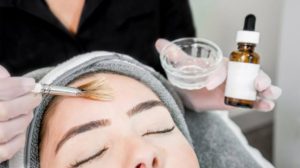A good option for those with spots on the skin is a peeling action, which is a type of cosmetic treatment that corrects signs of aging, blemishes, scars, injuries and improves the appearance of the skin. A great solution is a chemical peel with retinoic acid
Read also::https://carebeautyco.com/onions-and-almonds-to-eliminate-hair-breakage/

Peeling causes the surface, middle or deep layer of the skin to shed, through the application of products on the skin, eliminating dead cells, which leads to new, healthy and new skin just like the skin of a child, free of impurities and wrinkles. .
when do you peel off
Peeling is indicated whenever there is low self-esteem due to wrinkles, scarring or deformation of the skin, especially in visible areas such as the face, and the choice of the type of peeling depends on the assessment of the skin.
Peeling types
There are several types of peeling:
chemical peel – based on acids, such as glycolic or retinoic acid, for example, which exfoliate the skin layer;
physical exfoliation – using devices that perform a delicate scraping of the skin, known as dermabrasion;
Peeling is where the skin is removed by the energy of laser light.
Any type of exfoliation works well, and the difference between them is the depth the skin reaches and the price.
What is the most appropriate chemical peeling?
Superficial peeling works on the upper layer of the skin, the epidermis, and is indicated in cases of acne and skin aging due to the sun, light spots, fine wrinkles, enlarged pores and freckles, as well as dull skin.
A medium peel acts on the upper dermis and has the same indication as a superficial peel as well as more severe skin lesions and acne. On the other hand, deep peeling works on the deepest dermis and is indicated for example in blemishes, scars and moderate wrinkles.
How is a chemical peel done?
Before the procedure, it is necessary to prepare it about 15-30 days before using a cream prescribed by a dermatologist.
Chemical peels can be done with products such as retinoic acid, glycolic acid, phenol or salicylic acid for example, and the product must be kept for 5 to 30 minutes on the skin, which begins to peel off, allowing it to fall off and appear new, smoother, smoother and uniform.
Be careful after peeling to recover well
After peeling, the skin should be moistened for a week and then use thermal water, and wash the face with a neutral soap for about 7 days after the procedure.
In addition, it is necessary to apply sunscreen at least 30 times every 4 hours, which prevents UVA and UVB rays and prevents exposure to the sun and the use of make-up during the first week because the skin is sensitive. The use of acids should be resumed after only seven days, as the skin will become sensitive.
What are the complications of peeling?
In general, peeling does not cause complications, but aggravation of spots or burns can occur, especially if the care recommended by a dermatologist is not respected.
To avoid complications, it is preferable to perform the peeling in the winter when the sun is more moderate.
where do you peel off
Peeling should be done in cosmetic clinics by a dermatologist and specialized specialists to be a safe treatment.

